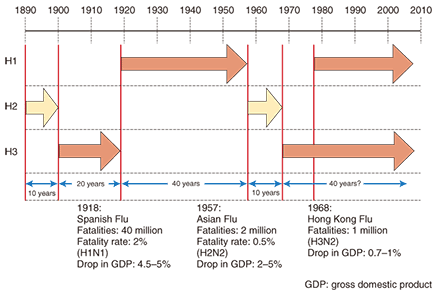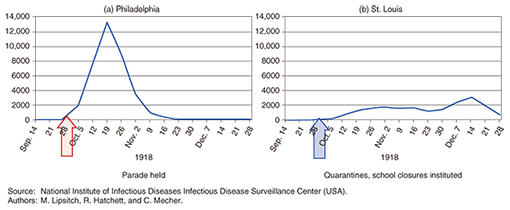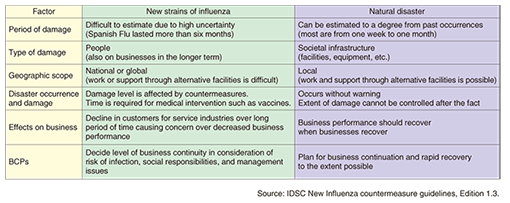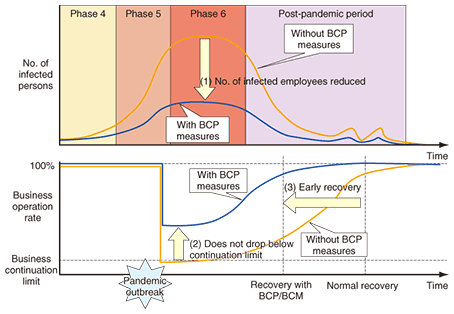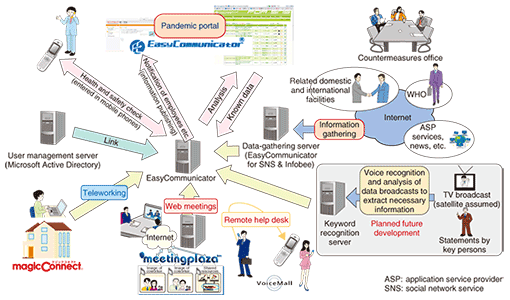 |
|||||||||||||||||||
|
|
|||||||||||||||||||
|
Special Feature: ICT-based Risk Management and Business Continuity Management Vol. 8, No. 1, pp. 27–32, Jan. 2010. https://doi.org/10.53829/ntr201001sf4 Information Technology Solutions Supporting Measures for Handling PandemicsAbstractThis article introduces information-technology-based solutions supporting measures for handling pandemics. The threat of the 2009 Swine Flu epidemic and occurrences of other worldwide pandemics have led to various business continuity measures being advanced in industry and in national and local governments. The basic strategy is to systematically reduce and restrict the amount of business and activity, limiting the rate of infection within and outside companies and bringing an end to the pandemic and a return to normal business activity as soon as possible. This is to be done in conjunction with discussions of appropriate measures for continuing and supporting societal functions, while planning and coordinating with industry and national and local governments.
1. IntroductionThe first case of infection from Swine Flu (H1N1 strain) in Japan was confirmed in Osaka on May 9, 2009. This outbreak has spread to over 100 countries around the world, not only threatening peoples’ lives, but also providing a reminder of the huge effect that infections can have on our daily activities. In Osaka and Hyogo prefectures, schools were closed, events were suspended, and residents were asked to stay home and limit their movements. This has greatly affected many people and businesses. Companies asked employees to wait at home for further instructions and prohibited business trips overseas and to the Kanto area of Japan, which had a major impact on business activities. If the infection spreads even further, the situation could deteriorate further, and full-blown measures from the national and local governments to prevent the spread of the infection will require employees to refrain from going to work over long periods of time. Many people have become concerned about how their companies will be able to carry on their business in such a situation. As of July 31, 2009, there have been over 4986 cases of infection in Japan and 134,503 confirmed cases worldwide, with 816 fatalities (Fig. 1). The World Health Organization (WHO) [1] defines the spread of influenza in terms of six phases [2], [3]. Phases 4 and above require companies and regions to take measures.
These measures also have economic effects, which we describe using examples from past pandemics in Section 2. Then, in Section 3, we describe business continuity plans (BCPs) and business continuity management (BCM) solutions available from NTT IT. 2. Pandemics and their economic impact2.1 Economic impact of pandemicsNew strains of influenza that have caused pandemics in the past have recently been recognized as seasonal influenza (Fig. 2). For example, Spanish Flu (influenza A strain subtype H1N1), which raged in 1918 resulting in over 40 million fatalities, is now recognized as a type of seasonal influenza. According to the World Bank, the decrease in worldwide gross domestic product caused by an influenza pandemic is estimated to be:
The actual scale of damage depends on the virulence and infectiousness of the virus and cannot be estimated. The spread of SARS (severe acute respiratory syndrome) in China in 2002 and 2003 is estimated by the Asian Development Bank to have caused losses of US$60 billion throughout Asia. 2.2 Lessons learned from Spanish FluWith Spanish Flu, there were major differences in mortality rates between the cities of Philadelphia and St. Louis in the USA, as shown in Fig. 3. In Philadelphia, a parade was held after the flu had started to spread, but before it was well recognized. In contrast, in St. Louis schools were closed and prohibitions on going out were instituted around the same time. This shows the importance of gathering accurate information, analyzing it carefully, and implementing thorough, public, and appropriate measures. It also shows that reducing direct contact between people is a highly effective measure.
2.3 Characteristics of pandemicsWhen an actual pandemic occurs, the work absentee rate can reach 40% due to employee illness, family illness, and fear. Furthermore, factors such as home quarantine, school closures, and panic can raise it to 50% or 60%. There are significant differences between pandemics and other natural disasters, such as earthquakes, hurricanes, flooding, and forest fires (Table 1). Specifically, pandemics can affect all societies globally (they are not local phenomena), and there is a possibility of stopping the domino effect of pathogen arrival. The physical infrastructure is not destroyed, but the circulation of goods can stop. The first wave can continue for six to eight weeks, though Spanish Flu actually persisted for about seven months. Everyone suffered equally, with the crisis threatening the lives of individuals. According to one report, about 30% of the population contracted the disease (40% among school-aged children and 40% among adults).
3. BCPs and BCM solutions for pandemicsA BCP for pandemics should aim to decrease the infection rate among employees, ensure limits for business continuation are maintained, and achieve early recovery. Measures to achieve these objectives (Fig. 4) include BCPs that assume 40–60% absence from work; established methods for gathering, analyzing, and distributing information; established methods for reducing direct contact between people; and education and training during non-crisis times. NTT IT offers four BCM solutions for pandemic measures (Figs. 5 and 6).
(1) EasyCommunicator [4] is an emergency management/business continuity solution that provides unified gathering and distribution of information, health status management, and safety checking. (2) MagicConnect [5] provides a teleworking environment that avoids direct contact between employees. (3) MeetingPlaza [6] provides a web-based meeting environment for meetings without any direct contact between participants. (4) VoiceMall [7] provides a remote help-desk environment that allows employees to answer customer calls to company phones from home when attendance at the office is prohibited. EasyCommunicator can automatically gather relevant information posted on the web pages of sources such as WHO and Japan’s Ministry of Health, Labor and Welfare. Members of the emergency management team can analyze this information and create a mash-up of the content, which is then automatically posted on the web on a pandemic portal to notify employees. It is also distributed by email to employees via their mobile phones or home personal computers (PCs) at the same time. The system can also confirm the reception of notifications, so the state of employee health and safety can also be checked through PCs or (i-mode) mobile phones. The number of contracts for and installations of these services is currently on the increase. NTT IT provides one-stop consulting for pandemic measure solutions [8]. We provide services and systems that can be used every day, and not just in the event of an emergency. References
|
|||||||||||||||||||









